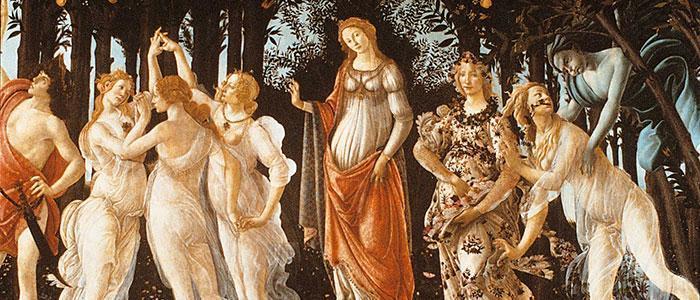
For dem der er fascineret af de smukke italienske monumenter og ikke vil nøjes med en overfladisk viden, vil vores italienske kunsthistorie gøre det muligt at uddybe historien og den sociale kontekst, hvor disse mesterværker er blevet opfattet og realiseret.
Dette kursus har i sigte at vise kunstudviklingen i Italien i forhold til resten af Europa og at introducere de vigtigste kunstneriske stilarter (romersk, gotisk, renæssance, barok) gennem videofremskrivninger, dybtgående analyser og guidede ture i vores land.
Kurset repræsenterer en unik mulighed for at lære om og forstå kunstværker som Botticelli, Leonardo da Vinci, Raphael og Michelangelo samt de historiske og sociale arrangementer, der fulgte med dem.
Se de detaljerede programmer som tilbydes i hver by (på engelsk):
History of Italian Art in Florence
- Introduction:
- General and historical lists;
- The Romanesque period.
- The XIII century:
- Architecture - passage of the French Gothic in Italy;
- The "Italian" Gothic;The sculpture: from Nicola Pisano to Arnolfo di Cambio.
-
The architectural and urban transformation between the XIII and the XIV century
- Florence and Siena in the XIV century:
- Cimabue and Duccio;
- Giotto;
- Simone Martini and the Lorenzetti brothers;
- Florence in the second half of the century;
- Traces of international Gothic.
-
Brunelleschi and the revolution of perspective:
-
The three fathers of the Italian Renaissance: Brunelleschi, Donatello, Masaccio
-
-
The first Renaissance:
-
Florence in the first half of the XV century
-
-
Florence in the second half of the XV century:
-
The cultural environment of Lorenzo il Magnifico and Botticelli
-
-
Leonardo da Vinci
-
Raphael and Michelangelo.
History of Italian Art in Milan
The course program is comprised of two parts:
- Theoretical lessons, which are held in the school classrooms and are dedicated to introducing students to Italian history and art history, and specifically how those artistic periods correspond to the history of Milan.
- Outdoor lessons, which are held at the end of the course and aim to deepen those topics that the students liked the most and to visit the artistic monuments of the city of Milan.
During the lessons the use of visual materials will be very important and useful. The artistic periods are introduced and presented by giving students the visual image of the main artistic works (paintings, sculptures, architectural monuments, etc.) of that period. The visual support consists of images, VHS, and CDRom material.
Example of program:
- Celtic Tribes to Roman Empire: The first Celtic settlements and the arrival of the Romans. Archeological revivals of Roman culture and analysis of the first urban centers. Analysis of three architectural styles, S. Lorenzo basilica.
- Early Christian Milan to the foundation of the Commune: The importance of St. Ambrogio, the Christian culture, and the invasion of Longobard. S.Simpliciano basilica, Sant’ Ambrogio. Analysis and characteristics of the Romanesque style.
- Medieval Milan and Visconti lordship: The chronology of the Visconti family tree. Milan medieval monuments such as Mercanti square and St. Eustorgio basilica. General characteristics of Gothic style architecture and Gothic monuments in Milan such as St. Marco square and Duomo cathedral.
- The Sforza family and the Renaissance: The court of the Sforza family and Sforzesco Castle. Analysis and characteristics of the birth of the Renaissance in Florence. The Renaissance in Milan including artists such as Filarete and Bramante, and monuments such as Santa Maria delle Grazie, Santa Maria, and San Satiro.
- Leonardo da Vinci: His life and works, his period in Milan, and the history and an analysis of The Last Supper, his unique masterpiece.
- The Spanish domination: the Mannerism period, featuring artists such as Caravaggio, Carracci, and Rubens. Analysis and characteristics of Baroque architecture. St. Alessandro church, Palazzo Marino, Palazzo del Senato, The House of Omenoni, and Palazzo Durini.
- French and Austrian domination: Maria Teresa of Austria and the reform of Napoleon Bonaparte. Neoclassic achitecture. Palazzo di Brera, Palazzo Reale, La Scala Theatre, Foro Bonaparte, Parco Sempione, Villa Reale, and Arco della Pace.
- Restoration, Revival, and the Kingdom of Italy: The Austrian Restoration and the war for the independence of Italy during the time of Garibaldi. The Industrial Revolution. Analysis of Eclecticism. Monumental Cemetery, Vittorio Emanuele Gallery.
- Fascism and Rationalism: Mussolini and fascist architecture in Milan (Piacentini). Liberty Style. Analysis of the characteristics of Rationalism. Muzio and Giò Ponti. Central Railway Station, San Babila Square and The Palace of Justice.
History of Italian Art in Rome
Are you fascinated by Italy’s magnificent cultural works? Our course on the History of Italian Art will enable you to understand its history and social background. The course is designed to show, by means of slides and guided visits, the development of art in Italy in relation to the rest of Europe and offers you an introduction to the most important artistic styles (Romanesque, Renaissance, Baroque, Rationalism and Modern). You will become acquainted with the most important works of artists such as Raphael, Michelangelo, Bernini, Borromini and Caravaggio while learning about the most significant historical and social events that accompanied them.
The program foresees the following subjects:
- Introduction: ROME - the Eternal City
- Ancient Rome:
- the Forum Romanum (Foro Romano);
- the Palatine (Palatino);
- the Imperial Forums;
- the Colosseum;
- the Capitol.
- Medieval Rome:
- Trastevere;
- Santa Maria in Trastevere;
- Basilica Santa Cecilia;
- Santa Maria in Cosmedin and la “Bocca della verità”;
- San Clemente.
- The Vatican city:
- St. Peter’s;
- St. Peters square;
- the Vatican Museums.
- Il Barocco:
- Gian Lorenzo Bernini – Piazza Navona, elephant Obelisk, S. Maria sopra Minerva;
- Francesco Borromini - Francesco Borromini’s S. Ivo alla Sapienza;
- Michelangelo Merisi da Caravaggio - San Luigi dei Francesi, Sant’Agostino and Santa Maria del Popolo;
- Galleria Borghese.
- Rome’s Rationalism District:
- EUR.
- Contemporary Rome:
- the Ara Pacis;
- the Auditorium.
--------------------------------
To spend a vacation in Rome means being in contact with history, art and a wide variety of cutlural phenomena.
Our History of Art in Rome course is an opportunity to get to know the city of Rome throughout the course of its historical and artistic evolution. We start with the classical era, exploring it through the texts of ancient writers and the direct experience of monuments which have survived the passage of centuries. We then move onto Christianity, which had its early development in this city, via the works of sacred art found in local churches and convents. We will then acquire an appreciation for the whimsical Baroque and Rococo masterpieces that decorate the piazzas and streets. We’ll conclude with works of art and architecture of the period after 1870, when Rome became the capital of Italy.
The History of Art in Rome course consists of classroom sessions as well as on-site visits across the city. The syllabus is constructed as a series of interlocking journeys of discovery.
The course begins in the classroom, using texts, slides, illustrations and maps to introduce the origins of the history of Rome and its development through time.
Rome from its beginnings to the Empire: Our focus is on major monuments of classical antiquity, such as the Roman forum complex, the Colosseum and the Pantheon, which trace both the political and cultural evolution of Rome from the period of the Republic to that of the Empire.
Early Christian and Medieval Rome (4th – 13th centuries): We explore the churches and convents which gave visual form to Christian spirituality in their architecture, mosaics, frescoes and altarpieces by such masters as Cavallini, Torriti, Rusuti, etc.
Renaissance Rome (15th-16th centuries): We experience the world-renowned masterpieces of Michelangelo, Raphael and Bramante in churches and palaces such as the Vatican basilica and Villa Farnesina, as well as innovative urban spaces like the Capitoline piazza and the Via Giulia.
Baroque Rome (17th-18th centuries): Our topic is the triumph of fantasy in the fountains, palaces and churches of Bernini and Borromini and their successors, with particular emphasis on the areas of Piazza Navona, Piazza Quirinale and the Spanish Steps.
Rome the Capital (1870) and Fascist Rome: We investigate the period in which Rome was transformed into a modern capital by the Savoy monarchy, which commissioned wide avenues and enclosed piazzas. Later, with Mussolini, Rome regained its central role as the symbol of classical culture, as seen in the EUR quarter and the Italico Forum.
History of Italian Art in Siena
Students will approach most classical art and artists of the Italian culture and in particular fine examples they can find in Tuscany and that are still
nowadays part of the local background. In every class students will be able to watch images of works of art and will be informed about biographies
of the artists.
Middle ages
Romanesque and Gothic culture. Influences from France and Northern Europe. Religious and civic architecture in Florence, Siena, Pisa, Venice.
Churches and City Halls. Local examples of S.Antimo and S.Galgano abbeys.
Nicola and Giovanni Pisano and the pulpits of Pisa, Siena, Pistoia: from the antique to the Gothic style. Cimabue, Giotto, Duccio and the technique
of the fresco. The Basilica of St. Francis in Assisi
The Sienese painting in the XVI Century
After Duccio: Simone Martini, the Lorenzetti brothers and comparison with Florentine Renaissance.
The importance of the Sienese school of painting in Italy.
The Renaissance
Florence and the « Quattrocento ». Brunelleschi, Donatello, Masaccio, Iacopo della Quercia, Della Robbia brothers. The big commissions of the
Baptistery and the Dome. Mastery of the perspective and artistic leadership of the city in Europe. Italian Courts. Varied examples of Renaissance style
in Italy: Mantova, Urbino, Milano, Pienza. The magnificence of Popes and patrons. The increasing fame of the artists.
New techniques: canvas, oil, printing. The genius of Michelangelo, Raffaello, Leonardo, Tiziano. Antiquity and nature as source of inspiration.
The Mannerism
The crisis of the XVII Century in architecture, sculpture and painting. Giorgio Vasari, Pontormo, Domenico Beccafumi, Giambologna.
Læs tidligere elevers erfaringerne!
Flora Tinoco Da Cunha Valle
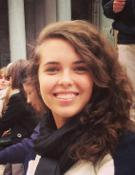
- + Navn: Flora Tinoco Da Cunha Valle
- + Land: Brasilien
- + Kursus: Kunsthistorie
Min erfaring med kunsthistorie i Rom:
"Jeg har altid haft et stort ønske om at lære italiensk og lære mere om den italienske kultur. En ting, der fascinerer mig ved Rom er at man finder kunstværker og arkitektur på hvert hjørne. At studere kunsthistorie på skolen var det ideelle supplement til at kunne nyde det alt det jeg så i byen. Undervisningen gav mig muligheden for at forstå hvad jeg oplevede hver dag. Jeg kan nu genkende kunsthistoriens perioder, der skiller sig ud i byen, og jeg kan sige, at jeg kender Rom med fortrolighed"
Felipe Ochoa
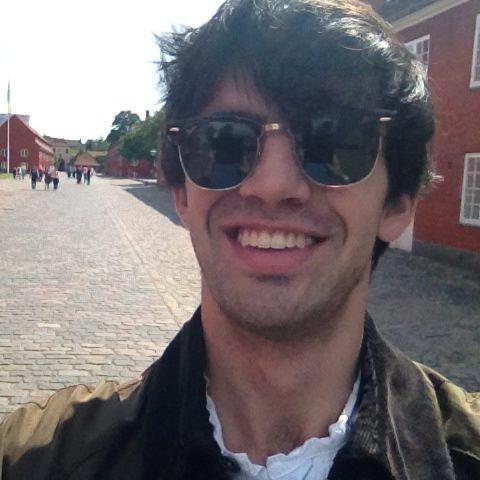
- + Navn: Felipe Ochoa
- + Land: Irland
- + Kursus: Kunsthistorie
Min erfaring med italiensk kunsthistorie i Milano:
"Kunsthistorie-undervisningen var fantastisk, jeg lærte om græsk og romersk arkitektur og om kunst fra begyndelsen af renæssancen til 1800-tallet. Nu kan jeg forstå italiensk kunst lidt bedre og derefter tale om det på italiensk."
Alex Grasso
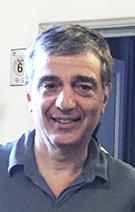
- + Navn: Alex Grasso
- + Land: USA
- + Kursus: Kunsthistorie
"Jeg havde booket et kursus i Kunsthistorie fordi jeg ønskede at finde ud af mere om de mange museer i Firenze. Jeg vidste, at kurset var på italiensk, og jeg ville kunne have svært ved at følge med, men Monica var fantastisk: Hendes sprog er meget tydeligt, hendes entusiasme er smitsom og det er tydeligt at hun kender og elsker kunsten i Firenze og renæssancen. Hun forklarede de vigtige oplysninger for os og fortalte os selv de mest trivielle og underholdende detaljer. Hun er den bedste, for alle der ønsker at lære mere om de største kunstneriske institutioner, også dem der er mindre kendte. Jeg kan ikke vente med at komme tilbage til Firenze og tage et nyt kursus med Monica."
Lucy Vannata
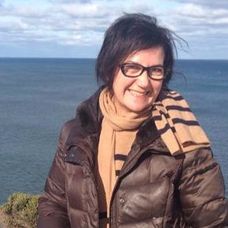
- + Navn: Lucy Vannata
- + Land: Australia
- + Kursus: Kunsthistorie
"Jeg vil stærkt anbefale et kursus i kunsthistorie hos Leonardo da Vinci-skolen. Vi var heldige at have en lære som Monica, uddannet og meget forberedt på at guide os. Udflugterne er på italiensk og nemme at forstå, da Monica havde tilpasset udflugten efter vores behov og niveau. Det, jeg bedst kunne lide ved undervisningen, var dens evne til at bringe historierne og hovedpersonerne til liv! Det var virkelig fantastisk, at forestille sig Michelangelo, Botticelli og de andre kunstnere og billedhuggere arbejde i deres tid.
Det var også meget spændende at høre om familien Medicis hemmeligheder og om deres rolle for Firenze. Vi følte at vi virkelig kendte dem grundet at Monica var i stand til at fortælle deres historier så levende og med evig energi og entusiasme! Tak Monica!"

 Danish (DA)
Danish (DA)  English (UK)
English (UK)  Italian (IT)
Italian (IT)  French (FR)
French (FR)  Japanese (JA)
Japanese (JA)  German (DE)
German (DE)  Russian (RU)
Russian (RU)  Spagnolo (ES)
Spagnolo (ES)  Português (pt-PT)
Português (pt-PT)  Nederlands (nl-NL)
Nederlands (nl-NL)  Czech (CZ)
Czech (CZ)  Polacco (PL)
Polacco (PL)  Turkish (TR)
Turkish (TR)  Korean (KR)
Korean (KR)  Magyar
Magyar  Українська (Україна)
Українська (Україна)  简体中文(中国)
简体中文(中国) 
